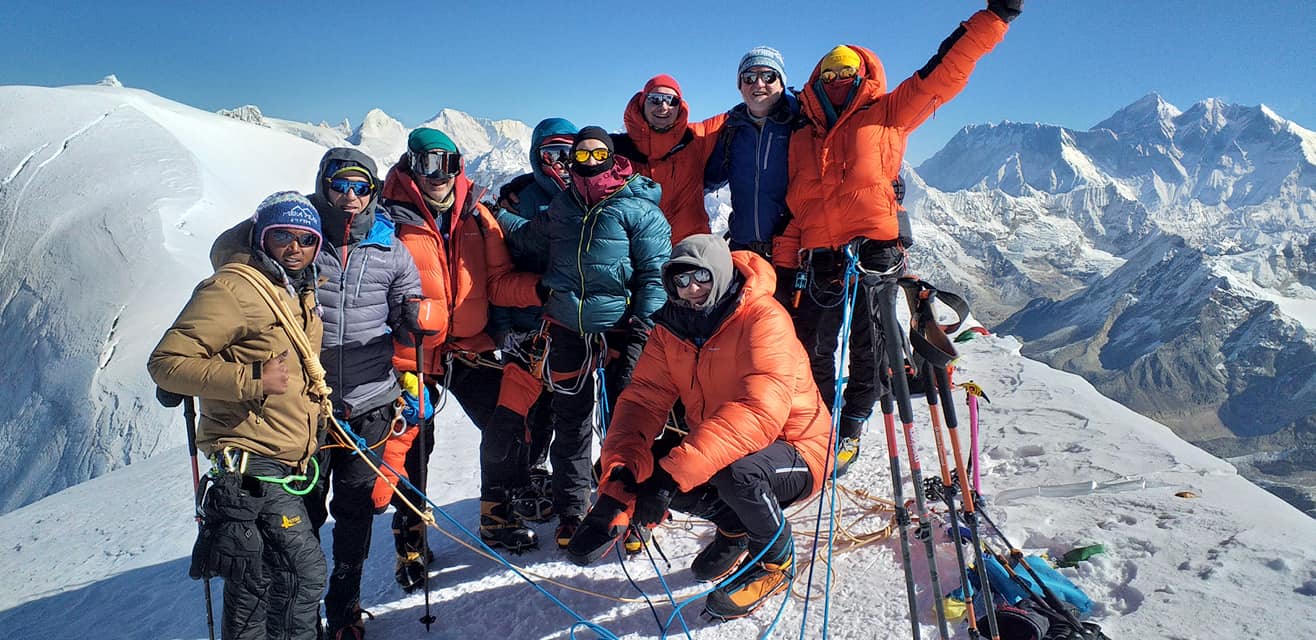Mera Peak, located in the Solu Khumbu region of Nepal, stands tall as one of the most sought-after trekking peaks in the Himalayas. With its stunning views, adventurous terrain, and the thrill of reaching the summit, Mera Peak offers a truly majestic and awe-inspiring experience for climbers. Rising to an impressive altitude of 6,476 meters (21,247 feet), Mera Peak offers panoramic views of some of the world’s highest peaks, including Everest (8,848 meters) and Lhotse (8,516 meters).
Mera Peak climbing combines the thrill of trekking in the Everest region with the exhilaration of reaching the summit of a Himalayan peak. It provides an excellent opportunity for both experienced climbers and adventurous trekkers to test their skills and push their limits. While Mera Peak is considered a non-technical climb, it does require a good level of physical fitness, endurance, and proper acclimatization due to the high altitude.
Join us as we delve into the intricacies of Mera Peak climbing, uncovering the challenges, preparation, permits, and safety considerations to help you embark on this extraordinary Himalayan expedition.
Table of contents:
1. Difficulties and Challenges in Mera Peak Climbing
- High altitude and acclimatization issues
- Technical aspects and basic mountaineering skills required
- Weather conditions and unpredictable terrain
- Physical endurance and fitness requirements
- Importance of experienced guides and support staff
2.Training and Preparation for Mera Peak Climbing:
- Physical fitness and endurance training
- Cardiovascular exercises and strength training
- Endurance-building hikes and trekking in hilly terrain
- Altitude acclimatization techniques and gradual ascent
- Familiarization with climbing equipment and basic mountaineering skills
- Choosing Suitable Seasons for Mera Peak Climbing:
- Overview of different seasons and their characteristics
- Best time to climb based on weather and visibility
- Peak seasons versus off-peak periods
- Considerations for crowd levels and availability of resources
- Permits and Logistics for Mera Peak Climbing
- Obtaining the Mera Peak climbing permit from the Nepal Mountaineering Association (NMA)
- Trekking permits required, such as Sagarmatha National Park entry permit and TIMS card
- Important documentation and registration processes
- Planning travel arrangements, accommodations, and transportation
- Choosing a Trustworthy and Affiliate Agency for Mera Peak Climbing
- Importance of research and reviews
- Look for reputable agencies with experienced guides and trained staff
- Check affiliations with mountaineering associations and adherence to safety protocols
- Seek recommendations from fellow climbers or experienced trekkers
- Safety Provisions and Considerations
- Packing essential gear and equipment for Mera Peak climbing
- Proper clothing for varying weather conditions
- First aid kit and necessary medications
- Hydration and nutrition considerations
- Emergency response plans and communication devices
- Safety in Group climbing:
- Communication
- Knowledge of Emergency Procedures
- Experienced Leader
- Teamwork and Support
- Regular Safety Briefings
- Weather Monitoring
- Safety Equipment
- Difficulties and Challenges in Mera Peak Climbing:
Embarking on the journey to conquer Mera Peak presents a host of difficulties and challenges that demand utmost resilience. The high altitude poses a significant hurdle, requiring careful acclimatization to the thinning air and reduced oxygen levels. Additionally, the climb necessitates technical expertise and proficiency in basic mountaineering skills, such as navigating through icy slopes and using climbing equipment effectively. Weather conditions in the Everest region are notorious for their unpredictability, subjecting climbers to harsh elements and precarious terrain. To endure the demanding expedition, one must possess physical endurance and optimal fitness levels to tackle long, strenuous hikes and conquer steep ascents. 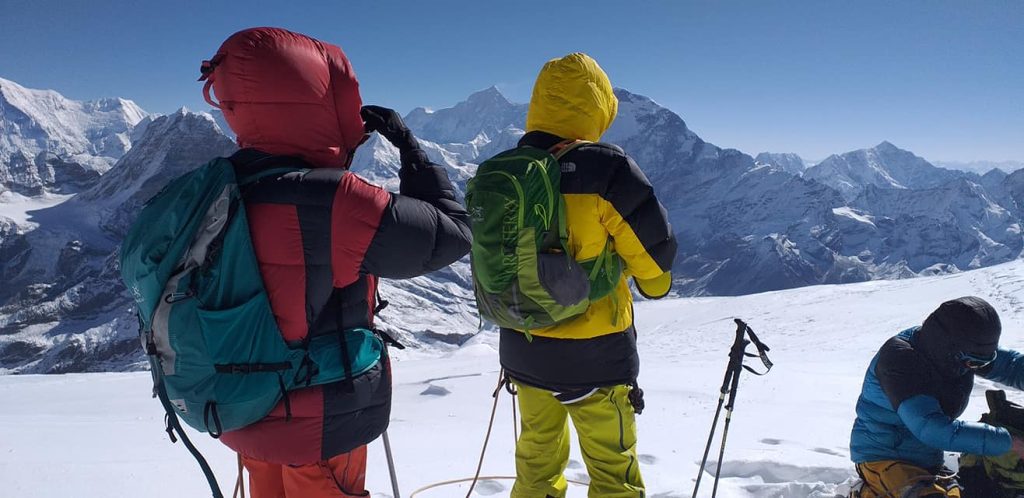
Moreover, the guidance and support of experienced guides and support staff are indispensable, as they provide invaluable knowledge, expertise, and assistance in ensuring a safe and successful climb. Conquering Mera Peak requires determination, preparation, and a steadfast commitment to overcoming the array of challenges that lie ahead.
- Training and Preparation for Mera Peak Climbing:
Training and Preparation for Mera Peak Climbing are crucial to ensure a safe and successful ascent. Physical fitness and endurance training form the foundation of preparation. Engaging in regular cardiovascular exercises such as running, hiking, or cycling improves stamina, while incorporating strength training exercises builds essential core and leg muscles necessary for trekking and climbing. Endurance-building hikes and treks in hilly terrain gradually enhance stamina and prepare the body for prolonged physical activity. Altitude acclimatization techniques, including gradual ascent and regular rest days at specific altitudes, allow the body to adapt to reduced oxygen levels and minimize the risk of altitude sickness. Familiarity with climbing equipment, such as crampons, ice axes, and harnesses, is vital. Gaining basic mountaineering skills like self-arrest, walking with crampons, and using an ice axe for stability ensures climbers are prepared for the technical aspects of the climb.
- Choosing Suitable Seasons for Mera Peak Climbing:
Choosing the suitable season for Mera Peak Climbing is essential to maximize safety, comfort, and overall enjoyment. Different seasons in the Everest region offer distinct characteristics. The best time to climb largely depends on weather conditions and visibility. The spring season (March to May) and autumn season (September to November) are considered the most favorable. During spring, the weather is mild, and the mountains are adorned with beautiful rhododendron blooms. Autumn brings stable weather, clear skies, and excellent visibility, making it popular among climbers. These seasons are considered peak seasons, attracting more climbers, which may lead to crowded trails and limited availability of resources. Off-peak periods like winter (December to February) and monsoon (June to August) have their own challenges, including cold temperatures, snowfall, or heavy rainfall. However, they offer a quieter experience with fewer crowds. Considerations for crowd levels and availability of resources should be taken into account while choosing the season, balancing between optimal weather conditions and personal preferences.
Simple Itinerary:
Day 01: Arrival to Kathmandu.
Day 02: Kathmandu exploration and preparation for trek.
Day 03: Fly to Lukla 2800m and trek to Paiya.
Day 04: Paiya to Pangkongma
Day 05: Pangkongma to Nigmsow
Day 06: Trek to Chhatra Khola
Day 07: Chhatra khola to Kothe
Day 08: Kothe to Thangnak
Day 09: Thangnak to Khare
Day 10: Khare to Mera peak base camp
Day 11: Base camp to High camp
Day 12: High camp to Mera peak summit and back to Khare
Day 13: Khare to Kothe
Day 14: Kothe to Thuli Kharka
Day 15: Thuli Kharka to Lukla
Day 16: Lukla to Kathmandu
Day 17: Final Departure
- Permits and Logistics for Mera Peak Climbing
Permits and logistics play a vital role in organizing a successful Mera Peak climbing expedition. To embark on the journey, climbers must obtain the Mera Peak climbing permit from the Nepal Mountaineering Association (NMA). This permit ensures compliance with regulations and helps support the local economy. Additionally, trekkers need to acquire the necessary trekking permits, including the Sagarmatha National Park entry permit and the Trekkers’ Information Management System (TIMS) card. These permits allow access to the designated trekking routes and contribute to the conservation efforts in the region.
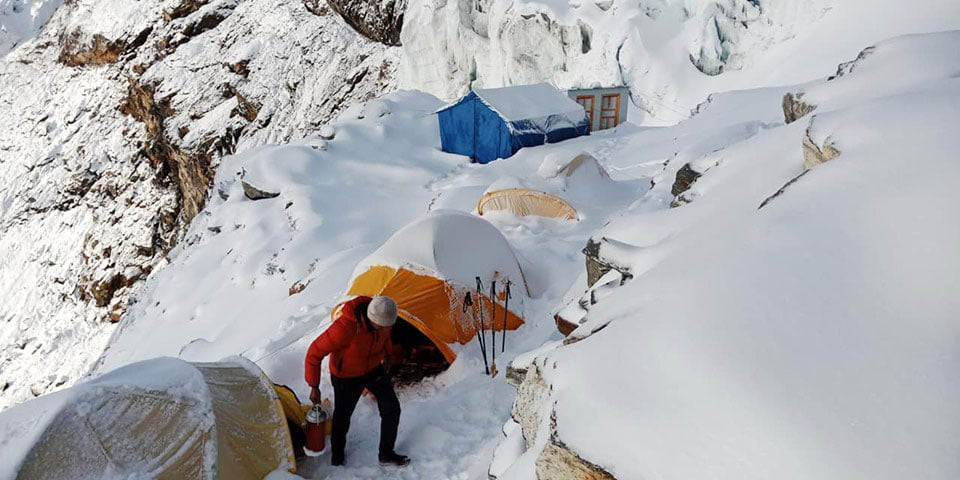
It is important to be aware of the required documentation and registration processes to ensure a smooth and hassle-free experience. Planning the travel arrangements, including flights to and from Nepal, accommodations in Kathmandu and during the trek, and transportation to the starting point of the trek, should be done in advance. Considering the popularity of Mera Peak, it is advisable to make arrangements early to secure preferred accommodations and transportation options. Thorough preparation and attention to permits and logistics will help climbers navigate the administrative aspects of the expedition and enjoy a seamless trekking experience.
- Choosing a Trustworthy and Affiliate Agency for Mera Peak Climbing
When it comes to choosing an agency for Mera Peak climbing, conducting thorough research and considering various factors is crucial. Start by delving into reviews and testimonials to gauge the agency’s reputation and track record. Look for well-established companies that boast experienced guides and trained staff, as their expertise and knowledge of the region can significantly enhance your climbing experience. Check if the agency holds affiliations with reputable mountaineering associations, as this indicates their commitment to safety and adherence to established protocols. Seeking recommendations from fellow climbers or experienced trekkers can also provide valuable insights and help you make an informed decision. Trustworthiness and reliability are paramount when entrusting your safety and success to an agency, so take the time to choose wisely and ensure your climb is supported by a reputable and affiliate partner.
- Safety Provisions and Considerations
Safety provisions and considerations are of utmost importance when undertaking Mera Peak climbing. Packing the essential gear and equipment is crucial for a safe and comfortable expedition. This includes a sturdy and well-fitted backpack, trekking boots with good ankle support, layered clothing to adapt to varying weather conditions, a warm and lightweight sleeping bag, a waterproof and windproof jacket, gloves, a hat, sunglasses, and a headlamp. A comprehensive first aid kit should be packed, including necessary medications for common ailments and high-altitude sickness.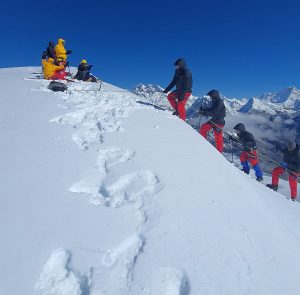
Hydration is vital at high altitudes, so climbers should carry a sufficient supply of water and consider using water purification tablets. Nutritious and high-energy snacks are essential for sustaining energy levels during the trek. Additionally, climbers should have an emergency response plan in place, including knowledge of emergency exit routes and communication devices such as a satellite phone or a reliable means of communication to seek help in case of emergencies. Being well-prepared with safety provisions ensures climbers can navigate the challenges of the climb with confidence and prioritize their well-being throughout the expedition.
- Safety in Group climbing:
Safety in group climbing is paramount for a successful and secure expedition. Establishing clear communication channels through tools like two-way radios or hand signals ensures that everyone stays connected and informed. Maintaining an appropriate group size enables effective supervision and coordination, reducing risks. An experienced leader, well-versed in mountaineering techniques and emergency procedures, makes informed decisions and guides the group effectively. 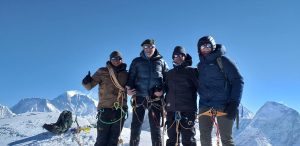
Fostering a spirit of teamwork and support encourages assistance and resource-sharing among climbers. Regular safety briefings reinforce protocols and keep the group prepared for unforeseen circumstances. Vigilance in monitoring weather conditions allows for timely adjustments to mitigate risks. Equipping all members with appropriate gear and ensuring its maintenance promotes reliability. Finally, familiarizing the group with emergency procedures and conducting drills enhances preparedness. Prioritizing these aspects fosters a safe and cohesive climbing experience.
Conclusion and Encouragement:
In conclusion, conquering Mera Peak is an extraordinary feat that offers immense fulfillment and rewards. Prioritizing safety, proper training, and choosing the right support are essential for a successful climb. Thorough preparation, physical fitness, and endurance training are key. Experienced guides and support staff play a vital role in ensuring a smooth and secure journey. Safety should always be a top priority, including acclimatization, proper gear, and awareness of altitude sickness. Beyond the summit, Mera Peak offers a chance to connect with nature, push your limits, and achieve a profound sense of accomplishment. So, prepare well, stay safe, and embark on an unforgettable adventure that will create lifelong memories.
Choosing Family Adventure for Mera Peak:
By choosing Family Adventure Treks & Expedition for your Mera Peak climbing adventure, you gain numerous benefits that enhance your experience and ensure a safe journey. With our expertise and experience, we provide comprehensive guidance and support, prioritizing your safety at every step. Our tailored itineraries cater to the unique dynamics of family adventures, allowing for proper acclimatization and rest days. From handling permits and logistics to arranging accommodations and transportation, we provide professional support, allowing you to focus on enjoying the experience with your family. Our experienced guides add depth to your adventure, sharing our knowledge of the region’s culture and history. By fostering a positive and enjoyable atmosphere, Family Adventure Treks & Expedition creates a memorable climbing experience for you and your family.

